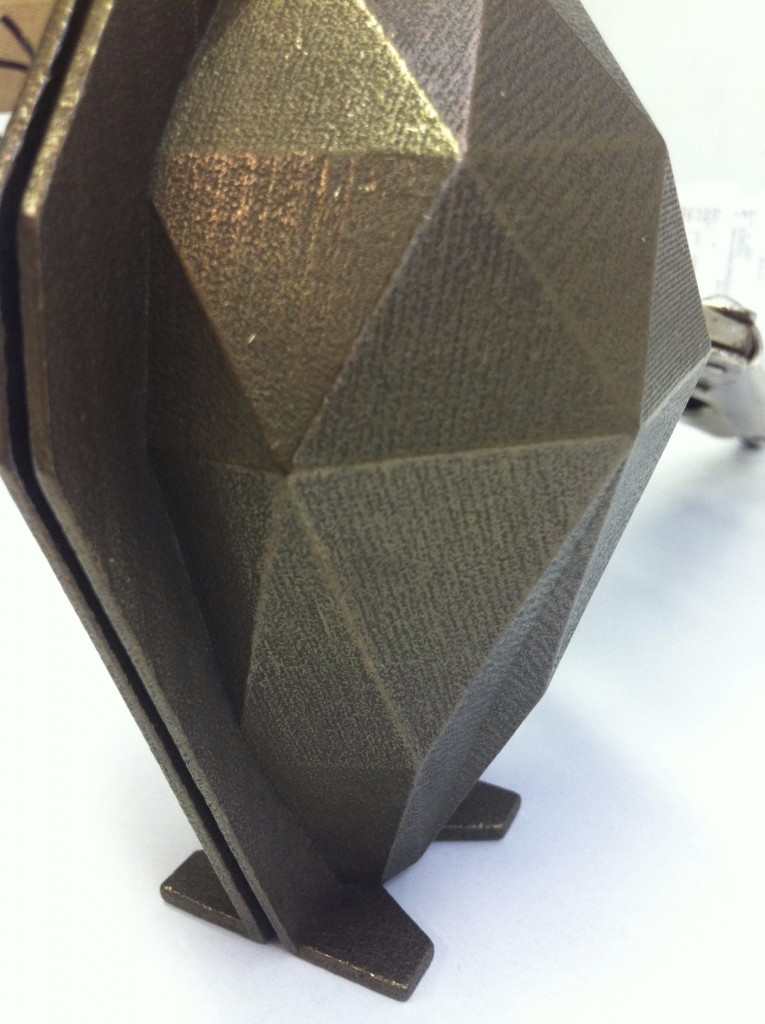As with all basic substances, it is impossible to know exactly how the invention of glass occurred. However, it is speculated that it developed as a result of sand blowing into the kilns used by the Ancient Egyptians to fire faience stoneware. Small glass bottles, cobalt in color, were prized by Cleopatra and since then, the obsession with the transparent substance has followed humanity and driven art and technology to new heights.
Glass blowing has long fascinated artist Tim Belliveau, graduate of Alberta College Art & Design and together with two of his fellow artists he founded his own glass studio called Bee Kingdom Glass. This year, Belliveau was the recipient of the Hexagram Grant, a program at Concordia University that funds exploration in the plastic arts, and he used his award to investigate the possibilities for glass blowing presented by 3D printing. In conjunction with his assistant Armel Desrues, he designed a digital model for a mold to be used in shaping blown glass. The artist explained the process of working on the mold:
“After some trial and error, I was able to create a 3D printed bronze mold in two parts which is designed for glass blowing. The trick is to keep the mold as thin as possible to limit expense (it is not cheap) but also thick enough to not bend or warp when hot glass is blown into it.”
 The files were sent to Shapeways for printing, and Belliveau felt like a kid when he received the final printed piece:
The files were sent to Shapeways for printing, and Belliveau felt like a kid when he received the final printed piece:
“Shape ways sent my completed 3D print in th email. It’s kind of like Christmas to open up something like this, that I’ve never touched – only worked on for hours in 3D software.”
To work with molten glass, a globule of the plasma-like substance is gathered onto the edge of a hollow metal tube. Air is blown through the tube with the mouth, and the shape expands. Some glass blowing is free form while at other times pieces are created by moving the molten glass into a mold and then blowing air into it, so that it expands in the cavity of the mold. The mold is then opened and the glass removed in order to continue further refinement (such as that seen in the video). Rather than designing hinges to allow the mold to open or remain shut, he decided to simply hold the two halves together with grip wrenches. This greatly reduced the expense for printing the mold and worked equally effectively.
The tools and methods of any particular process leave their own unique impression upon the final product. In this case, it is possible to see the fine layer lines created in the 3D printed mold in the glass itself, leaving a ‘fingerprint’ by which its process of creation could always be detected. Belliveau isn’t the first one to experiment with mass artisanal production:
“The background for this project was my interest in old Roman mold-blown glass which goes back to about 100 CE. One of the first brand-name artists, Ennion, was renowned from making these mold blow pieces in super sharp detail – always with his name pressed into it – which allowed for the pieces to be made very fast and repeatable.”
As further inspiration, he took a trip to New York to view some of his predecessor’s work at the Metropolitan Museum of Art. For more of his work, check out his website and for a chuckle, make sure you read the FAQs.
Subscribe to Our Email Newsletter
Stay up-to-date on all the latest news from the 3D printing industry and receive information and offers from third party vendors.
You May Also Like
3D Printing Unpeeled: New Arkema Material for HP, Saddle and Macro MEMS
A new Arkema material for MJF is said to reduce costs per part by up to 25% and have an 85% reusability ratio. HP 3D HR PA 12 S has been...
3D Printing News Briefs, January 20, 2024: FDM, LPBF, Underwater 3D Printer, Racing, & More
We’re starting off with a process certification in today’s 3D Printing News Briefs, and then moving on to research about solute trapping, laser powder bed fusion, and then moving on...
3D Printing Webinar and Event Roundup: December 3, 2023
We’ve got plenty of events and webinars coming up for you this week! Quickparts is having a Manufacturing Roadshow, America Makes is holding a Member Town Hall, Stratafest makes two...
Formnext 2023 Day Three: Slam Dunk
I’m high—high on trade show. I’ve met numerous new faces and reconnected with old friends, creating an absolutely wonderful atmosphere. The excitement is palpable over several emerging developments. The high...
































